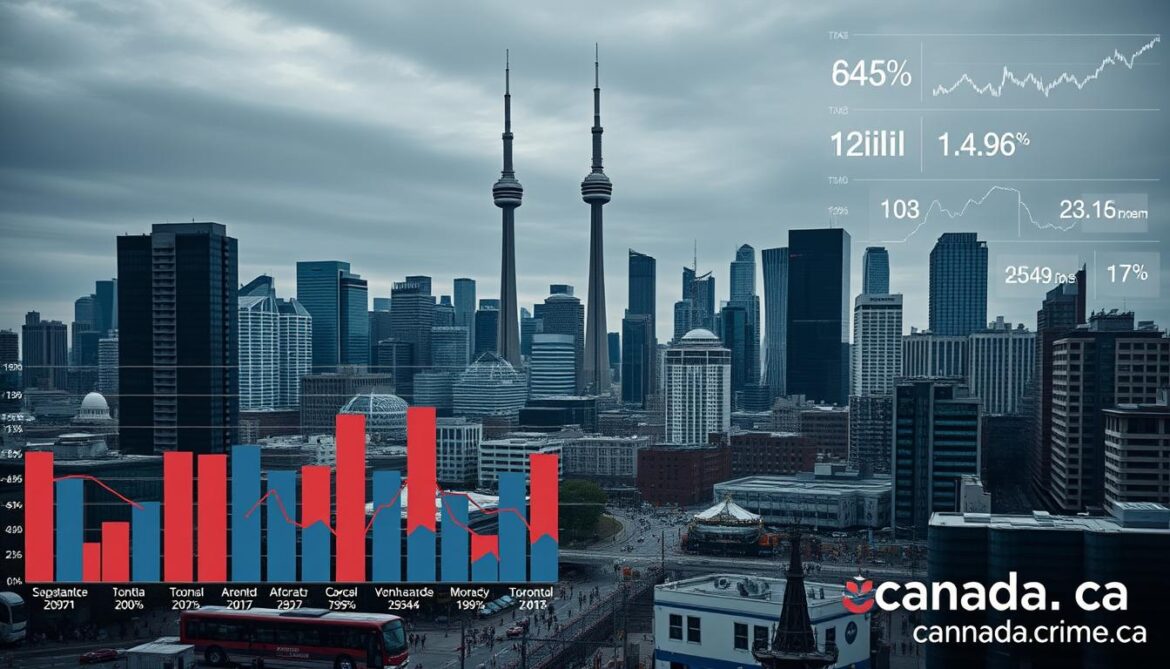Toronto, once firmly ensconced in the top 10 of the Global Liveability Index, slipped to 12th place in 2024, according to The Economist Intelligence Unit (EIU). Despite this drop, the city remains one of the safest major metropolitan areas globally, ranking eighth in personal security. A recent report by CTV News highlighted that Toronto boasts a crime rate of 286.9 offences per 100,000 residents, solidifying its position as Canada’s safest city.
This data not only underscores Toronto’s commitment to safety but also provides a foundation for understanding the nuances of its crime landscape. As we delve into the specifics of Toronto’s crime rates and the code that governs its reporting, we gain insight into the city’s overall security and the factors influencing it.
Current State of Crime in Toronto
The state of crime in Toronto is multifaceted, reflecting both positive trends and areas of concern. Various international rankings and local crime statistics offer insights into the city’s safety profile.
Toronto’s Safety Ranking in 2024
In 2024, Toronto’s safety ranking has been a subject of interest, with different organizations providing varying perspectives. The Economist Intelligence Unit ranked Toronto as the 6th safest major city globally and the safest in North America. Conversely, CEOWORLD magazine ranked Toronto 160th globally, though still safer than many comparable U.S. cities. This disparity highlights the complexity of evaluating city safety.

Major Crime Indicators in 2024
According to the Toronto Police Service, major crime indicators in 2024 show a 1.3% decrease compared to 2023, following a significant 19.8% increase from 2022 to 2023. The tracked major crimes include assault, auto theft, breaking and entering, robbery, and sexual violations.
| Crime Category | 2023 | 2024 | Change |
|---|---|---|---|
| Assault | 12,000 | 11,800 | -1.7% |
| Auto Theft | 8,000 | 8,200 | +2.5% |
| Breaking and Entering | 5,500 | 5,300 | -3.6% |
| Robbery | 4,500 | 4,400 | -2.2% |
| Sexual Violations | 1,200 | 1,150 | -4.2% |
Toronto’s overall crime rate stands at 286.9 offenses per 100,000 residents, positioning it as the safest major city in Canada. However, crime patterns vary significantly across neighborhoods, with downtown areas generally reporting higher incident numbers.
Historical Crime Rate Toronto Trends
The historical crime trends in Toronto reveal a complex pattern influenced by various socio-economic factors. Over the past three decades, the city has experienced fluctuations in its crime rate, with distinct periods of increase and decrease.
Crime Patterns from 1990-2010
In the early 1990s, Toronto witnessed a surge in violent crime, particularly in 1991 when the city recorded 89 homicides, largely attributed to gang conflicts and the emergence of crack cocaine in low-income neighborhoods. Throughout the 1990s, crime rates gradually declined, reaching a low in 1999 with 49 homicides, representing a murder rate of 1.68 per 100,000 people. The mid-2000s saw a concerning spike in gun violence, with 2005 being dubbed the “Year of the Gun” due to 52 gun-related homicides out of 80 total murders.
| Year | Homicides | Murder Rate per 100,000 |
|---|---|---|
| 1991 | 89 | 3.2 |
| 1999 | 49 | 1.68 |
| 2005 | 80 | 2.8 |
Crime Trends from 2010-Present
Following a period of relative stability between 2009-2015, with homicide totals stabilizing in the mid-50s and shooting incidents reaching a decade-low of 196 in 2014, Toronto has seen a troubling upward trend in violent crime since 2016. This culminated in 98 homicides in 2018, the highest total on record, partly influenced by the Toronto van attack that killed 10 people. Recent years have shown fluctuating patterns, with homicide rates ranging between 2.5 and 3.1 per 100,000 residents.

Understanding these historical crime trends is crucial for developing effective crime prevention strategies in Toronto. By analyzing the factors that have contributed to the city’s crime rate over time, law enforcement and policymakers can work towards creating a safer community for residents.
Comparing Toronto to Other Canadian Cities
A comparative analysis of crime rates in Canadian cities reveals Toronto’s relative safety. Toronto’s crime rate stands at 286.9 offenses per 100,000 residents, making it one of the safest major cities in Canada.
Toronto vs. Montreal, Vancouver, and Calgary
When comparing Toronto to other major Canadian cities, distinct patterns emerge. Montreal, with similar urban challenges, reports higher property crime rates but comparable violent crime statistics. Vancouver, known for its quality of life, has higher property crime rates, particularly in auto theft and breaking and entering. Calgary, despite facing urban growth challenges, outperforms Toronto in several safety metrics.
The crime rates of these cities are as follows:
| City | Crime Rate per 100,000 |
|---|---|
| Toronto | 286.9 |
| Montreal | Higher than Toronto (exact rate not specified) |
| Vancouver | Higher than Toronto (exact rate not specified) |
| Calgary | Lower than Toronto in several safety metrics |
| Quebec City | 301 |
| Ottawa-Gatineau | 318.8 |
Crime Severity Index Comparisons
The Crime Severity Index (CSI), which weights crimes by their seriousness, shows Toronto performing better than many comparable Canadian census metropolitan areas. This index provides a more nuanced view of crime rates, taking into account the severity of crimes committed.
Key findings include:
- Toronto maintains a low crime rate despite its high population density.
- The city’s CSI score is favorable compared to other major Canadian cities.
- Population density is a significant factor in crime rate variations among Canadian cities.

Toronto vs. American Cities: A Crime Rate Analysis
A comparative analysis of crime rates between Toronto and major American cities reveals intriguing differences in public safety challenges. This comparison is crucial for understanding the unique aspects of crime in Toronto and how it stacks up against other major North American cities.
Property Crime Comparisons
A recent study by the Fraser Institute found that Toronto’s property crime rate is 40% higher per capita than New York City’s. This surprising statistic challenges common perceptions about safety in these two major cities. Other Canadian cities, such as Hamilton and Windsor, also ranked higher for property crime than several American cities, including New York and Detroit.

The data suggests a distinct pattern in how property crimes manifest in Canadian urban environments compared to their American counterparts.
| City | Property Crime Rate |
|---|---|
| Toronto | Higher than New York |
| Hamilton | Higher than Detroit |
| Windsor | Higher than Flint and Ann Arbor |
Violent Crime Comparisons
Despite having a higher property crime rate, Toronto maintains a significantly lower violent crime profile than most comparable American cities. The homicide rate in Toronto has fluctuated between 2.1 and 3.8 per 100,000 people over the past decade, which is lower than cities like Chicago (18.5 per 100,000), Atlanta (19.0 per 100,000), and Boston (9.0 per 100,000).
However, Toronto’s shooting rate (18.1 per 100,000 people in 2019) was double that of New York City (9.1 per 100,000) in the same year, highlighting specific challenges with gun violence.
| City | Homicide Rate per 100,000 |
|---|---|
| Toronto | 2.1-3.8 |
| Chicago | 18.5 |
| Atlanta | 19.0 |
| New York City | 5.1 |
Neighborhood Crime Distribution in Toronto
Crime rates vary substantially across different neighborhoods in Toronto, reflecting complex urban dynamics. The city’s crime distribution is influenced by a multitude of factors including socioeconomic conditions, urban design, and policing strategies.

Neighborhoods with High Crime Rates
The West Humber Clairville neighborhood has reported the highest number of major crimes year-to-date, with 1,570 incidents, marking a 30.5% increase from the previous year. Other neighborhoods experiencing high crime rates include Downtown Yonge East with 705 incidents, Moss Park with 695 incidents, and York University Heights with 690 incidents. These areas are characterized by high population densities and significant commercial activities, contributing to the higher crime volumes.
Some neighborhoods are witnessing alarming increases in crime. For instance, Princess-Rosethorn has seen a 215.3% rise in major crimes, while Kingsway South is up by 140.7%. These significant increases suggest shifting crime patterns that require targeted intervention.
Safest Neighborhoods
In contrast, Woodbine-Lumsden is statistically the safest neighborhood, with only 50 reported major crimes, representing a 35% decrease from the previous year. This neighborhood’s low crime rate can be attributed to its residential nature and effective policing strategies.
The distribution of crime across Toronto’s neighborhoods highlights the need for nuanced crime prevention strategies tailored to the specific challenges of each area. By understanding these variations, law enforcement and urban planners can work together to create safer communities.
Understanding Toronto’s Crime Code System
Toronto employs a sophisticated crime classification system that allows for nuanced crime analysis. This system is crucial for understanding the city’s crime dynamics and for developing effective crime prevention strategies.
Major Offence Categories
The Toronto Police Service categorizes crimes into Major Crime Indicators (MCIs), which serve as key metrics for monitoring public safety. The top ten major offences reported in 2024 include:
- Assault — 18,818 incidents (up 5.7%)
- Auto Theft — 7,045 incidents (down 21.3%)
- Breaking and Entering — 5,030 incidents (down 3.6%)
- Robbery — 2,312 incidents (up 5.7%)
- Sexual Violations — 2,630 incidents (up 13.1%)
The classification system distinguishes between different degrees of similar crimes, such as simple assault, assault with a weapon (4,489 cases), and assault causing bodily harm (1,001 cases).
How Crimes Are Classified and Reported
Toronto’s crime rate is typically expressed per 100,000 people to facilitate comparisons with other cities. The reporting system feeds into national crime statistics tracked by Statistics Canada, which monitors annual homicide rates and other major crimes across metropolitan areas.
The crime code system is essential for researchers conducting comparative studies of crime rates and for policymakers developing targeted crime prevention strategies. By understanding how crimes are classified and reported, stakeholders can better analyze crime trends and implement effective interventions.

Specific Crime Trends and Concerns
Specific crime trends have emerged as major concerns in Toronto, necessitating a closer look at the data and potential solutions. Toronto faces several crime challenges that have significant implications for public safety and law enforcement strategies.
Gun Violence and Homicides
Gun violence remains a persistent issue in Toronto, with fluctuating levels of firearm-related homicides. The city experienced a significant spike in gun-related homicides in 2005, dubbed the “Year of the Gun,” with 52 out of 80 murders involving firearms. More recently, the homicide rate peaked in 2018 with 98 deaths, including 10 from the Toronto van attack, resulting in a rate of 3.6 per 100,000 people.
Auto Theft Epidemic
Auto theft has been a significant concern in Toronto, reaching epidemic proportions in recent years. However, 2024 data shows a 21.3% decrease in auto thefts, suggesting that targeted enforcement and prevention strategies may be having a positive impact.
Transit System Safety Issues
Transit system safety has been a major public concern, with violent incidents on the Toronto Transit Commission (TTC) increasing by 46% in 2022 compared to the previous year. However, there was a 24% decrease in offences against TTC riders between January 2023 and January 2024, indicating some improvement.
| Crime Type | Rate in 2022 | Rate in 2024 |
|---|---|---|
| Violent Incidents on TTC | 1,068 incidents | Decrease by 24% |
| Auto Theft | Significant increase | 21.3% decrease |
| Homicide Rate per 100,000 | 3.6 in 2018 | Not specified |
Preventing crime in Toronto requires a multi-faceted approach, including targeted law enforcement strategies and community engagement. The deployment of 80 Toronto Police officers for 24-hour patrols and the addition of 70 security personnel throughout the TTC system are steps towards enhancing public safety.

Organized Crime in Toronto
For over a century, Toronto has grappled with organized crime, from early homegrown gangs to sophisticated international syndicates. The city’s diverse population and its evolution over time have significantly influenced the development of various criminal groups.
The Evolution of Organized Crime
Organized crime has been a persistent element of Toronto’s criminal landscape since the mid-19th century. Initially, it was characterized by homegrown groups like the Markham Gang, which was short-lived. Over the years, it evolved to be dominated by international or foreign-based crime syndicates.
Italian organized crime has remained prevalent, with groups such as the Calabrian ‘Ndrangheta, specifically the Siderno Group, and the Sicilian Mafia being active. During Prohibition, Toronto became a major hub for bootlegging operations into the United States, attracting Italian-American organized crime, notably the Buffalo crime family.
Current Organized Crime Activities
Today, organized crime in Toronto is diverse, reflecting the city’s multicultural population. Groups operate across various ethnic and geographic areas within the city. Modern organized crime activities have expanded beyond traditional territories to include financial crimes, cyber offenses, human trafficking, and involvement in legitimate businesses as fronts for money laundering operations.
As the people of Toronto continue to experience the effects of organized crime, it remains a significant concern for law enforcement and the community. Efforts to combat these crimes require a deep understanding of the complex networks and activities of these organizations.

“The complexity of organized crime in Toronto demands a multifaceted approach to law enforcement and community engagement.”
Conclusion: The Future of Crime Prevention in Toronto
The city of Toronto stands at a crossroads in its crime prevention strategies, balancing traditional methods with innovative solutions. Recent data indicates a decrease in crime rates in 2024, with a 1.3% reduction in major crimes compared to the previous year. This trend is encouraging, yet persistent challenges require targeted approaches, particularly in vulnerable neighborhoods.
To address these challenges, the government has introduced several initiatives. For instance, the Toronto Transit Commission (TTC) has seen an increase in security measures, including the deployment of 80 additional police officers for 24-hour patrols, along with 20 community safety ambassadors and 50 security guards. These efforts aim to enhance safety and mitigate violent incidents on public transportation.
Future crime prevention in Toronto will likely rely on data-driven approaches, analyzing crime patterns across different census metropolitan areas to identify effective interventions. Research on crime trends suggests that a combination of traditional enforcement and community-based prevention strategies is crucial.
Toronto’s experience offers valuable lessons for other Canadian cities, particularly in balancing enforcement with prevention while maintaining relatively low crime rates. As Toronto continues to grow, ongoing investment in both traditional policing and innovative community-based prevention strategies will be essential.
Key areas of focus include property crime prevention, particularly addressing the auto theft epidemic, and addressing violent crimes such as assault and robbery with weapons. By adopting a multifaceted approach that includes law enforcement, community engagement, and social programs targeting at-risk populations, Toronto can continue to be one of North America’s safest major cities.

